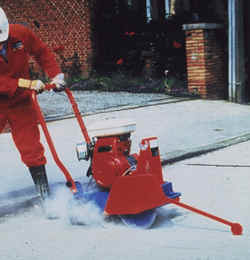|
|
Saw Sizes
General term for diamond
grits in sawing and drilling applications,
ranking in size from 20 mesh down
to 80 mesh.
One of the first families
of manufactured diamonds was aimed
at meeting the demands and needs
of a wide variety of sawing and drilling
applications.
Diamond products have been designed to offer
specific size, shape, strength and surface
characteristics which makes them appropriate
for stone, concrete and geological drilling
applications.
The size of crystals
used in cutting tools determines
both the amount of diamond exposed
(and hence the material removal rate),
as well as the number of crystals
per carat. As mesh sizes increase,
pieces per carat increase too. Since
the number of crystals on the surface
of a cutting tool influences tool's
life and performance, it is therefore
critical to choose the right or rather
most appropriate mesh size. For instance,
coarser crystals and greater exposure
could lead to faster material removal
rate.
|
|
|
|
" Well structured diamond crystals"
|
|
|
|
" Irregular crystal
shapes"
|
|
Diamond concentration also affects
the number of crystals on tool surface.
It is thus essential to obtain a
right balance between mesh size and
diamond concentration in order to
achieve a better performance (see
table under industrial diamonds/expertise).
|
|
|
|
Diamond crystals shape is another
property which influences tool performance.
Shapes can vary from perfectly shaped
cubo-octahedrons to totally irregular,
angular crystals. The more irregular
the shape, the less severe the application
should be. On the contrary, blockier
crystals will be more suited for
applications of greater severity.
|
|
|
" Blocky, cubo-octahedron
crystal diamond "
|
|
|
The strength of diamond crystals refers to their ability to withstand
impacts. This characteristic depends on crystal shape, size and
the presence of inclusions (i.e. entrapped metallic or nonmetallic
foreign materials such as iron, cobalt, nickel,…). The impact
strength required from a diamond product will increase jointly with
the toughness of materials being cut.
All diamonds being part of bond systems saw size diamonds are typically
combined with metal bonds. These bonds are usually made from cobalt,
nickel, iron or a combination of these metals.
Their major role regarding tool performance is to offer controlled
wear and crystal exposure, while preventing diamonds to be pulled
out. The choice of a bond system will thus also determine diamond
tools' performance.
Synthetic industrial diamonds have changed and shaped today's industrial
world, especially in the stone sector.
Saw size diamonds are being used in the stone processing industry,
in construction and renovation projects where diamond cutting and
drilling methods have induced costs cutting, increased productivity
and improved quality.
|
|
|

|
|
|
Floor saw cutting
concrete
|
|
Thanks to their prominent
characteristics, high grades
in diamond crystals offer improved
wear resistance, thermal stability,
extremely high strength, while
showing well structured crystal
shapes. These grades have been
designed for high performance
sawing and drilling applications,
such as concrete or wire sawing,
granite or core drilling. |
|
|
Medium grades present a wider variety of shapes and strength, are slightly
more friable but are still offering a large amount of cutting shapes.
Considered as most appropriate for dry cutting blades.
Low grades, highly friable, are best suited for lighter applications.
One can now easily understand how the introduction of superabrasive products
in the industrial world has brought about considerable benefits: longer
tool life, faster cutting rates, and greater accuracy for materials of
improved quality at competitive prices.
|
HUSQVARNA BELGIUM SA - CUSTODIAM
Avenue des Artisans, 50 - Zoning Industriel 2 - B-7822 Ath - Belgium
Tel: +32 (0)68 25 14 44 - Email: custodiam@husqvarnagroup.com
|



